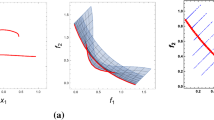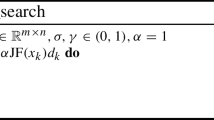Abstract
Reference point-based methods are very useful techniques for solving multiobjective optimization problems. In these methods, the most commonly used achievement scalarizing functions are based on the Tchebychev distance (minmax approach), which generates every Pareto optimal solution in any multiobjective optimization problem, but does not allow compensation among the deviations to the reference values given that it minimizes the value of the highest deviation. At the same time, for any \(1 \le p \le \infty \), compromise programming minimizes the \(L_p\) distance to the ideal objective vector from the feasible objective region. Although the ideal objective vector can be replaced by a reference point, achievable reference points are not supported by this approach, and special care must be taken in the unachievable case. In this paper, for \(1 \le p < \infty \), we propose a new scheme based on the \(L_p\) distance, in which different single-objective optimization problems are designed and solved depending on the achievability of the reference point. The formulation proposed allows different compensation degrees among the deviations to the reference values. It is proven that, in the achievable case, any optimal solution obtained is efficient, and, in the unachievable one, it is at least weakly efficient, although it is assured to be efficient if an augmentation term is added to the new formulation. Besides, we suggest an interactive algorithm where the new formulation is embedded. Finally, we show the empirical advantages of the new formulation by its application to both numerical problems and a real multiobjective optimization problem, for achievable and unachievable reference points.




Similar content being viewed by others
Notes
By compensation degrees between the deviations to the reference values. we refer to the effect that is obtained by aggregating the power p of all the individual deviations to the reference values. In the \(L_p\) distance, the higher the value of p, the more importance is given to the higher deviation (in absolute value).
There is more up to date data from this survey but it does not contain data on satisfaction related variables.
The precise wording of the questions was: How satisfied are you with your present job in terms of ...?
For each \(j=1, \ldots , 7\), the index r in Eq. (22) refers to the number of individuals (observations) in the sample of size N considered for the survey but, once the econometric techniques are applied to estimate the coefficients \(\beta _i^j\) (\(i=1, \ldots , 35\)) and \({\alpha }^j\), r is eliminated. Thus, (22) leads to seven equations.
The two sets of constraints (not reported to conserve space -available upon request-) are: (a) technical constraints, which ensure that certain binary variables do not take the value 1 simultaneously, and (b) some constraints to ensure that the profile of the worker that we are looking for is sufficiently realistic (e.g. defining bounds for the salary depending on the individuals’ highest education level).
We have not included the values of the variables due to space reasons.
The deviation of satisfaction with working time from the reference point also holds negative correlation with earnings (\(-0.490\)), job security (\(-0.978\)), type of work (\(-0.968\)) and number of working hours (\(-0.821\)).
References
Deb, K., & Miettinen, K. (2008). A review of nadir point estimation procedures using evolutionary approaches: A tale of dimensionality reduction. In Technical Report KanGAL Report Number 2008004, Indian Institute of Technology. Kanpur, India: Kanpur Genetic Algorithms Laboratory (Kan-GAL).
Deb, K., & Miettinen, K. (2010). Nadir point estimation using evolutionary approaches: Better accuracy and computational speed through focused search. In M. Ehrgott, B. Naujoks, T. J. Stewart, & J. Wallenius (Eds.), Multiple criteria decision making for sustainable energy and transportation systems (pp. 339–354). New York: Springer.
Deb, K., Miettinen, K., & Chaudhuri, S. (2010). Towards an estimation of nadir objective vector using a hybrid of evolutionary and local search approaches. IEEE Transactions on Evolutionary Computation, 14(6), 821–841.
Deb, K., Thiele, L., Laumanns, M., & Zitzler, E. (2002). Scalable multi-objective optimization test problems. In Congress on Evolutionary Computation (pp. 825–830).
Ehrgott, M. (2000). Multicriteria optimization. In Lecture Notes in Economics and Mathematical Systems. Springer.
Ehrgott, M., & Gandibleux, X. (2002). Multiple criteria optimization. State of the art annotated bibliographic surveys. Dordrecht: Kluwer Academic.
Ehrgott, M., & Tenfelde-Podehl, D. (2003). Computation of ideal and nadir values and implications for their use in MCDM methods. European Journal of Operational Research, 151(1), 119–139.
Freeman, R. B. (1978). Job satisfaction as an economic variable. American Economic Review, 68, 135–141.
Hwang, C. L., & Masud, A. S. M. (1979). Multiple objective decision making—Methods and applications: A state-of-the-art survey. Berlin: Springer.
Luque, M., Miettinen, K., Eskelinen, P., & Ruiz, F. (2009). Incorporating preference information in interactive reference point methods for multiobjective optimization. Omega, 37(2), 450–462.
Luque, M., Miettinen, K., Ruiz, A. B., & Ruiz, F. (2012). A two-slope achievement scalarizing function for interactive multiobjective optimization. Computers & Operations Research, 39(7), 1673–1681.
Luque, M., Ruiz, F., & Miettinen, K. (2011). Global formulation for interactive multiobjective optimization. OR-Spectrum, 33(1), 27–48.
Marcenaro-Gutierrez, O. D., Luque, M., & Ruiz, F. (2010). An application of multiobjective programming to the study of workers’ satisfaction in the Spanish labour market. European Journal of Operational Research, 203(2), 430–443.
Miettinen, K. (1999). Nonlinear multiobjective optimization. Boston: Kluwer Academic Publishers.
Miettinen, K., & Mäkelä, M. M. (2002). On scalarizing functions in multiobjective optimization. OR-Spectrum, 24(2), 193–213.
Podkopaev, D. (2007). An approach to finding trade-off solutions by a linear transformation of objective functions. Control and Cybernetics, 36, 347–355.
Ruiz, F., Luque, M., & Cabello, J. M. (2009). A classification of the weighting schemes in reference point procedures for multiobjective programming. Journal of the Operational Research Society, 60(4), 544–553.
Ruiz, F., Luque, M., Miguel, F., & Muñoz, M. M. (2008). An additive achievement scalarizing function for multiobjective programming problems. European Journal of Operational Research, 188(3), 683–694.
Sawaragi, Y., Nakayama, H., & Tanino, T. (1985). Theory of multiobjective optimization. Orlando: Academic Press.
Steuer, R. E. (1986). Multiple criteria optimization: Theory, computation and application. New York: Wiley.
Wierzbicki, A. P. (1980). The use of reference objectives in multiobjective optimization. In G. Fandel & T. Gal (Eds.), Multiple criteria decision making, theory and applications, volume 177 of Lecture Notes in Economics and Mathematical Systems (pp. 468–486). Springer.
Wierzbicki, A. P. (1982). A mathematical basis for satisficing decision making. Mathematical Modelling, 3(25), 391–405.
Wierzbicki, A. P. (1986). On the completeness and constructiveness of parametric characterizations to vector optimization problems. OR-Spectrum, 8(2), 73–87.
Yu, P. L. (1973). A class of solutions for group decision problems. Management Science, 19(8), 936–946.
Yu, P. L. (1985). Multiple-criteria decision-making: Concepts, techniques, and extensions. New York: Plenum Press.
Zeleny, M. (1973). Compromise programming. In J. Cochrane & M. Zeleny (Eds.), Multiple criteria decision making (pp. 262–301). Columbia: University of South Carolina Press.
Zeleny, M. (1974). A concept of compromise solutions and the method of the displaced ideal. Computers & Operations Research, 1(3), 479–496.
Acknowledgments
This research was partly supported by the Spanish Ministry of Innovation and Science (MTM2010-14992 and ECO2014-56397-P) and by the Andalusia Regional Ministry of Innovation, Science and Enterprises (PAI groups SEJ-532 and SEJ-445).
Author information
Authors and Affiliations
Corresponding author
Rights and permissions
About this article
Cite this article
Luque, M., Ruiz, A.B., Saborido, R. et al. On the use of the \(L_{p}\) distance in reference point-based approaches for multiobjective optimization. Ann Oper Res 235, 559–579 (2015). https://doi.org/10.1007/s10479-015-2008-0
Published:
Issue Date:
DOI: https://doi.org/10.1007/s10479-015-2008-0




